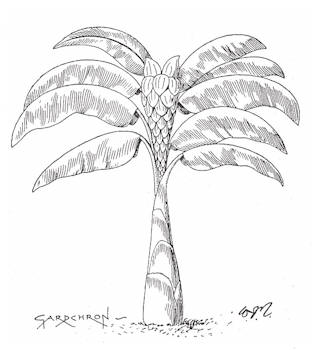Musa wilsonii
Musa wilsonii W. J. Tutcher, Gardeners' Chronicle series 3, 32: 450 [fig. 151: 451] (1902), & Revue Horticole 34 (1903).
| Accepted name |
Ensete wilsonii (W. J. Tutcher) E. E. Cheesman, Kew Bulletin 2 (2): 101 (1947). or more probably Ensete glaucum (W. Roxburgh) E. E. Cheesman, Kew Bulletin 2 (2): 101 (1947). |
| Synonyms | Ensete glaucum (W. Roxburgh) E. E. Cheesman, Kew Bulletin 2 (2): 101 (1947). |
| Authorities |
The authority for the accepted name is Flora of China. The synonym is from Simmonds 1960. The World Checklist of Monocotyledons lists Musa wilsonii Tutcher, Gard. Chron., III, 32: 450 (1902) as a synonym of Ensete wilsonii (Tutcher) Cheesman, Kew Bull. 2: 103 (1947 publ. 1948) which is given as an accepted name. |
| Section | |
| Distribution | China (endemic to Yunnan). |
| Description |
Plant 10 - 12 ft. high. Trunk conical, 5 ft. long to lowest leaves, 15 - 16 in. in diameter at base. Leaves, including
stalk, 10 - 12 ft. long by 2 - 22/3 ft. broad. Inflorescence drooping, 3 ft. long, 15 in. in diameter at base, 4 - 5 in. at apex. Bracts, all persistent, lower 1 ft.long,
lanceolate, upper much shorter, ovate, at first green, becoming brown. Flowers 15 - 20 in two rows. Perianth nearly 2 in. long, three-lobed ; free petal short, three-cuspidate,
with a large, linear central cusp. Fruit with sweet pulp, 3½ - 4½ in. long, nearly 1½ in. broad at apex but narrowing much to base, yellow. Seeds about twenty, black, about ½ in.
in diameter. "Elephant's Head." Yunnan, China. "Cultivated for the inner portion of the trunk, which is used as food." Near M. glauca [Ensete glaucum]. (Fawcett 1913). |
| References | Cheesman 1947a : 103, Fawcett 1913 : 266, Lancaster 1989 : 196, Li 1981, Liu et al 2002, Flora of China, Simmonds 1960 : 208, 212, Tutcher 1902, Tutcher 1903, Wu 1997. |
| Comments |
I am very doubtful that Ensete wilsonii is distinct form Ensete glaucum.
The occurrence of the plant at high altitude, "below 2,700 m", implies that it should be reasonably cold hardy. The name "Snow Banana" is sometimes
applied to it but the source for this name is not known to us. Because of its supposed cold hardiness there have been several attempts to introduce the plant into cultivation via
seed. So far (last update) these attempts have been unsuccessful. Both Ensete glaucum and Ensete wilsonii occur in Yunnan and, although E. wilsonii occurs up
to 2,700 m. and E. glaucum only to 1,100 m. there is considerable altitudinal overlap. There is the possibility for confusion of identity in Chinese Ensete seed
offered commercially although examination of the leaf base of cultivated plants may perhaps be diagnostic. However, the seed that has been imported into Europe up to now, under the
name Musa wilsonii, has been true Musa seed (actually Musa basjoo) not Ensete seed. "When Mr. E. H. Wilson [ ] returned from his trip to Yunnan in 1899, he brought with him a few seeds of a Musa, which he informed me was cultivated by the natives of that province, and known by them as the "Elephant's Head" Banana (fig. 151). They cultivated it for the inner portion of the trunk, which was used for food. The seeds were sown on December 6, 1899 [ ] and these were growing in 8-inch pots in the spring of 1901, when they were planted out. By the end of the summer they had obtained a height of 6 to 7 feet. During the winter of 1901-02 the leaves died down to the trunk, but in the spring of this year new ones were pushed forth, and both plants flowered in June, the first flowers opening on the 25th of that month. The plants were then from 10 to 12 feet high, with about a dozen leaves each. [ ] It is a highly ornamental species, with broad arching leaves, 10 to 12 feet long. The trunk is conical, 5 feet long below the lowest leaves. [ ] It appears to be closely allied to Musa glauca Roxb. but differs from that species in having a much shorter trunk, much longer petiole and leaves, flowers twice as large, and wrinkled seeds. I have named it in honour of its discoverer." Cheesman uses the briefest of notes to transfer Musa wilsoni to Ensete wilsoni. Simmonds on the other hand states that it differs in no essential respect from
Ensete glaucum and reduces it. It is notable however that Simmonds says he does this without having seen any authentic material. On the evidence presented above, Wu Te-lin's maintenance of Ensete wilsonii as a species distinct from Ensete glaucum seems rather uncritical. However, in Flora of China the botanical differences between Ensete glaucum and Ensete wilsonii are specified as follows:
Neither Wu Te-lin nor Flora of China comment on Simmonds' contention that this plant is Ensete glaucum. Liu et al 2002 comment that Musa wilsonii used in the Chinese literature such as Fl. Reipubl. Popularis Sin. and Fl. Yunnan. is in fact a misidentification of M. itinerans Tutcher, Cheesman and Simmonds all use the epithet wilsoni. Modern practice under the International Code of Botanical Nomenclature recommends that an epithet
commemorating a person whose name ends in a consonant should have ii added, thus M. wilsonii and E. wilsonii as used by Mobot & Wu. Image of Musa wilsonii from Tutcher 1902. The drawing is perhaps by a staff illustrator and is rather stylised. The pseudostem is shown as distinctly conical and the inflorescence quite erect (Tutcher 1902 does not mention the orientation of the inflorescence but Fawcett describes it as drooping perhaps ex Tutcher 1903 - not seen by me). No Ensete has an erect inflorescence. It is a very odd looking plant from the drawing.
|
last updated 02/05/2008
